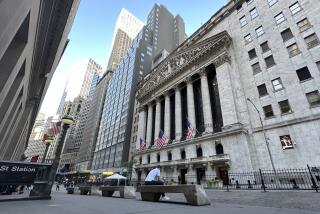‘Dogs’ Strategy Just Got Trickier
It’s getting tougher to find high-dividend-yielding stocks in the Dow Jones industrial average. And that may pose a challenge to followers of the “dogs of the Dow” investing strategy.
Dogs of the Dow is a contrarian strategy that calls for investing in the 10 highest-yielding stocks in the 30-stock index. Some investors make that investment once a year (often at year-end) and adjust the portfolio annually. Others re-balance the portfolio monthly if the highest-yielding list has changed.
Dividend yields (annual dividend payout divided by stock price) that are high have traditionally been a sign of undervalued or beaten-down stocks--hence the “dogs” idea. The theory behind buying the dogs is that they’re cheap and could be poised to rebound.
Historically the strategy has beaten the market, though in recent years it has fallen flat.
On Tuesday, Dow Jones & Co. said it would kick four stocks out of the Dow, three of which would be on a dogs list if assembled today. To be kicked out are: Sears, with a current dividend yield of 3.4%; Goodyear Tire, 2.9%; Chevron, 2.8%; and Union Carbide, 1.5%.
They are to be replaced by software giant Microsoft, which pays no dividend; chip maker Intel, with a yield of just 0.2%; retailer Home Depot, also yielding 0.2%; and telecommunications company SBC Communications, at 2.1%.
“We’ve felt that this strategy was losing some of its zeal anyway, since companies have changed their dividend policies and many companies quite frankly elect not to pay out any dividends,” said Charles Carlson, co-manager of the Strong Dow 30 Value fund.
The latest stock substitutions “seem to lessen the appeal of it that much more,” Carlson said.
But Chris Orndorff--head of equities for Los Angeles-based Payden & Rygel, whose Growth & Income Fund relies on a modified dogs of the Dow approach--says he doesn’t think the changes endanger the strategy.
“The theory is a relative one--you’re looking for the 10 highest-yielding stocks, not for stocks with yields over a certain level,” said Orndorff, adding that even after the changes go into effect, 29 of the 30 stocks will still pay out some dividend, even if minuscule.
Still, John Rekenthaler, research chief at fund tracker Morningstar Inc., noted that “this theory has always been predicated on [being able to invest] in some truly high-yielding stocks in the Dow. And I don’t know how many more of them are left.”
Meanwhile, investors who want to play the Dow 30 straight up--such as via a mutual fund--have limited options, though that may soon change, given the modernization of the index, analysts say.
Among retail funds, TD Waterhouse Dow 30 fund, Orbitex Focus 30 fund and Strong’s Dow 30 fund all invest exclusively in the Dow stocks, though to an extent Orbitex and Strong can pick and choose among the stocks.
Also, so-called Diamonds are American Stock Exchange-listed basket securities that hold all the Dow stocks. (Ticker symbol: DIA.)
Analysts caution, however, that with the Dow’s changes--especially with the heavier tech stake--these funds are likely to be more volatile than in the past. Whereas the Dow used to be considered a “value” investment play, it’s now tilting increasingly toward the “growth” side.
*
* DOW CHANGE: Main story, A1
(BEGIN TEXT OF INFOBOX / INFOGRAPHIC)
The New Dow 30
With the addition of Intel, Microsoft, SBC Communications and Home Depot, the Dow Jones industrial average becomes more tilted toward technology and consumer industries, and much less a heavy-industry index. A look at key data for the 30 stocks, including market capitalization (stock price times number of shares outstanding), dividend yield (annual dividend per share divided by current stock price) and stock price-to-earnings (P/E) ratio based on analysts’ consensus estimate of 1999 earnings per share:
*--*
Year Mkt. cap. Stock Div. ’99 Stock (ticker symbol) added (billions) price yield P/E TECHNOLOGY/TELECOM AT&T; (T) 1939 $141 $44.00 2.0% 20 Hewlett-Packard (HWP) 1997 78 76.63 0.8 22 IBM (IBM) 1979 173 95.50 0.5 26 Intel (INTC) 1999 246 71.44 0.2 32 Microsoft (MSFT) 1999 475 92.38 none 57 SBC Communications (SBC) 1999 156 45.56 2.1 21 CONSUMER PRODUCTS/SERVICES Coca-Cola (KO) 1932 137 55.50 1.1 43 Eastman Kodak (EK) 1930 22 68.19 2.6 14 Home Depot (HD) 1999 105 70.69 0.2 49 Johnson & Johnson (JNJ) 1997 142 105.31 1.1 35 McDonald’s (MCD) 1985 54 39.50 0.5 28 Merck (MRK) 1979 182 77.63 1.5 32 Philip Morris (MO) 1985 61 25.56 7.5 8 Procter & Gamble (PG) 1932 130 98.19 1.3 31 Wal-Mart (WMT) 1997 237 53.25 0.4 43 Walt Disney (DIS) 1991 52 25.25 0.8 38 FINANCIAL SERVICES American Express (AXP) 1982 65 144.75 0.6 27 Citigroup (C) 1997 164 48.50 1.2 18 J.P. Morgan (JPM) 1991 21 121.38 3.3 12 HEAVY INDUSTRY Alcoa (AA) 1959 22 61.19 1.2 23 AlliedSignal (ALD) 1928 29 52.38 1.3 19 Caterpillar (CAT) 1991 20 55.44 2.4 19 DuPont (DD) 1935 67 63.94 2.2 24 Exxon (XON) 1928 175 72.06 2.2 30 General Motors (GM) 1928 42 65.19 3.1 8 International Paper (IP) 1956 20 48.25 2.0 36 AEROSPACE Boeing (BA) 1987 43 44.88 1.3 20 United Technologies (UTX) 1939 26 54.69 1.4 18 CONGLOMERATES General Electric (GE) 1896 412 125.63 1.1 39 3M (MMM) 1976 39 95.81 2.4 24
*--*
Sources: Times research, Reuters, Bloomberg News
More to Read
Inside the business of entertainment
The Wide Shot brings you news, analysis and insights on everything from streaming wars to production — and what it all means for the future.
You may occasionally receive promotional content from the Los Angeles Times.










